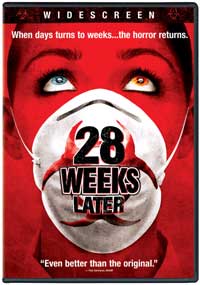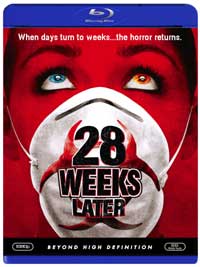


DVDSleuth.com is your source for daily DVD news and reviews.


28 Weeks Later (2007)
20th Century Fox Home Entertainment
DVD Released: 10/9/2007
All Ratings out of ![]()
![]()
![]()
![]()
![]()
Movie: ![]()
![]()
![]()
![]()
Video: ![]()
![]()
![]() 1/2
1/2
Audio: ![]()
![]()
![]()
![]()
Extras: ![]()
![]()
![]()
Review by Mike Long, Posted on 10/10/2007
OK, here's an odd question: Have you ever watched the sequel to a movie that you didn't like? Why on earth would anyone do this? Given the fact that sequels are typically inferior products, this idea seems like a total waste of time. Now, have you ever watched the sequel to a movie that you didn't like and found that you actually like the sequel? This was the case with 28 Weeks Later. The over-hyped original did nothing for me, but I found sequel to be contagious.
28 Weeks Later takes place...wait for it...28 weeks after the events of the first film. As you'll remember from the first film, Britain has been ravaged by a virus which causes the infected to be overcome by a mindless, violent rage. The virus is easily passed between victims and it takes effect in seconds. While the victims are technically alive, they become less than human. The virus quickly spread throughout the country, leaving few uninfected. As our story opens, we meet Donald (Robert Carlyle) and Alice Harris (Catherine McCormack), two survivors who are holed-up in a house with several others. Suddenly, the house is attacked by the infected, who overrun the place. Donald gets away, but he can't save Alice.
The scene then jumps to London, where we see a clean-up taking place. The United States Army has come in and taken over the city. They have set up a new headquarters on an island outside of London, and survivors are slowly being brought into the "safe" zone. The area is patrolled by armed snipers, including Doyle (Jeremy Renner), an American who passes the time watching strangers through his rifle scope. Donald is here, and he's anxious to see his children, Tammy (Imogen Poots) and Andy (Mackintosh Muggleton), who were out of the country on a trip when the infection struck. He greets them as they reach "District 1" and takes them to their new home in a high-rise where Donald is the caretaker. The kids attempt to settle in, but they are sad and restless, especially when Donald describes what happened to their mother. They decide to sneak back into London to gather personal belongings from their old flat. Once there, they discover a secret which will reintroduce the plague to the area. From that point on, the idea of rebuilding turns into one of survival.
When
28 Days Later hit U.S. theaters, it was greeted with a great deal of hype. I actually made my way to the cinema to catch it and found it to be boring and derivative. Thus, I had little hope for 28 Weeks Later, despite the fact that I'd heard good things about it. I was pleasantly surprised to find that the film is nearly the polar opposite of the first movie, despite the fact that they have similar plots and structures.28 Days Later attempted to create an air of doom and dread, but it ultimately strayed too far from the central idea of the infection wiping out humanity. 28 Weeks Later remains much closer to this idea, and the story does an excellent job of building upon itself. The film offers a brief updating of the situation from the first film -- in an opening scene which is incredibly intense and which sets the stage for the rest of the movie -- and then turns its attention to the new story. Despite the fact that we know something bad is going to happen eventually, after all, this movie wouldn't exist if it wasn't, 28 Weeks Later is able to lull the viewer into a false sense of security as we watch the survivors being to re-populate "District 1". Much to the credit of the screenwriters, when the situation does take a turn for the worst, it comes from a very unexpected and shocking place. From there, the movie doesn't full around to introduce any new subplots or grandiose ideas. Once the spread of the infection begins anew, the movie is focused solely on the audience watching a core group of characters attempting to survive.
Thusly, 28 Weeks Later is much more of an action-horror film than its predecessor. Director Juan Carlos Fresnadillo stages some wicked set-pieces here which are a combination of jarring gore and brutality, mingled with impressive special effects (the fire-bombing of London). As with the first film, the scenes in which the infected attack are a blur of hand-held camera and kinetic action. But, Fresnadillo peppers these scenes with new ideas, such as the moment in the fantastic opening where we get a bird's eye view of Donald fleeing from the infected (which was done using a camera mounted on a mini-helicopter). The visuals in 28 Weeks Later don't have the experimental feel of the first film. During the first 1/3 of the film, the movie is shot in a very natural style. But, as the virus returns, the shots become more tight and claustrophobic.
The emphasis on action here doesn't diminish the emotional impact. Despite the fact that this film feels fast-paced, it takes time to let us get a feel for the characters. Granted, we don't learn much about most of them, but we do get a general sense of which characters are likeable. Thus, when they die, and trust me, most of them do, their is an greater impact on the audience. For much of the film, I felt that the central characters were safe, but the death of one main character literally gave me chills and let me know that the movie was playing for keeps. These strong moments are inter-mingled with the expected "jump" scares and violent scenes which cause the viewer to wince.
Many felt that 28 Days Later was a genre-bending film, but I felt that it simply borrowed from many other movies. On the contrary, 28 Weeks Later is one of the few "zombie" (note that it's in quotes since they technically aren't zombies) to actually deal with the problem at hand. I don't want to watch a bunch of people standing around arguing about survival, I want to see them running for their lives. The movie's frenetic pace, graphic violence, and emotional shocks make for an experience which you'll want to pass along to those around you.
28 Weeks Later repopulates DVD courtesy of 20th Century Fox Home Entertainment. The film has come to DVD in two separate releases, one full-frame and the other widescreen. For the purposes of this review, only the widescreen version was viewed. The film has been letterboxed at 1.85:1 and the transfer is enhanced for 16 x 9 TVs. This movie was shot using a mixture of 35mm film, 16mm film, and Digital Video. Overall, the DVD transfer here looks much better than that found on 28 Days Later. For the most part, the image look very good. The image is sharp and clear, showing grain in only some shots. The colors look fine. The nighttime scenes (which were actually shot "day for night") are somewhat dark at times. Keeping in mind that I was viewing a preview DVD, the image did show some notable pixellation at times. The DVD has a Dolby Digital 5.1 audio track which provides clear dialogue and sound effects (although I can't ever understand Robert Carlyle!). This track provides excellent audio quality, as the track brings us a great deal of stereo and surround effects, as well as some nice bass response. Simply go to Chapter 17 to get a perfect example of the mixture of surround sound and deep, rumbling bass. The audio also comes into play for the "jump" scares.
This DVD has a number of solid extras. We start with an AUDIO COMMENTARY from director/co-writer Juan Carlso Fresnadillo and co-writer Enrique Lopez-Lavigne. This is an OK talk, but it's very dry at times. This may be due to the fact that English is not the native tongue of either participant. They do offer some insight into the filming of the movie, commenting on locations, actors, and how certain scenes were done. The DVD contains 2 DELETED SCENES which run about 5 minutes and can be viewed with optional commentary by Fresnadillo and Lopez-Lavigne. In a nice change of pace, both of these scenes are good and I would have liked to have seen them in the film. "Code Red: Making 28 Weeks Later" (13 minutes) offers behind-the-scenes footage and comments from the cast and crew, but unlike most "making ofs", it actually tells us the "hows and whys" of the film from the script to the production. Movement advisor Paul Kasey gives an overview of how the rage victims where choreographed in "The Infected" (7 minutes). In "Getting into the Action" (7 minutes) the actors talk about the challenge of filming the action scenes. "28 Days Later: The Aftermath: Stage 1 "Development" (7 minutes) and "28 Days Later: The Aftermath: Stage 3 "Decimation" (5 minutes) both feature semi-animated panels from the graphic novel which continued the story of the first film. Finally, we have the THEATRICAL TRAILER for 28 Weeks Later, letterboxed at 1.85:1 and 16 x 9.
28 Weeks Later also arrives on Blu-ray Disc. The video transfer is 1080p HD AVC and the film is letterboxed at 1.85:1. The image here looks very good, as it loses the pixellation and video noise of the DVD. Some scenes still look somewhat grainy (this could reflect the medium used in these shots), but overall the image is very sharp and clear. The amount of detail in the video are impressive and the colors look very good. The night-time scenes don't look quite as dark here. The opening sequence, with the green pastures, looks very good, and the image shows a very nice amount of depth. The Blu-ray has a DTS HD 5.1 master lossless audio track which runs at 1.5 Mbps. This track provides very clear and detailed audio. Again, simply skip to Chapter 17 to hear the force of this track as the surround sound and bass work together to really draw the viewer into the scene. The stereo effects are good and any crowd scene provides an opportunity for an amazing amount of different sounds to come through the front and rear channels. All of the extras on the Blu-ray are identical to the DVD. If you are planning on purchasing 28 Weeks Later, then the Blu-ray Disc is clearly the way to go.
Review Copyright 2007 by Mike Long